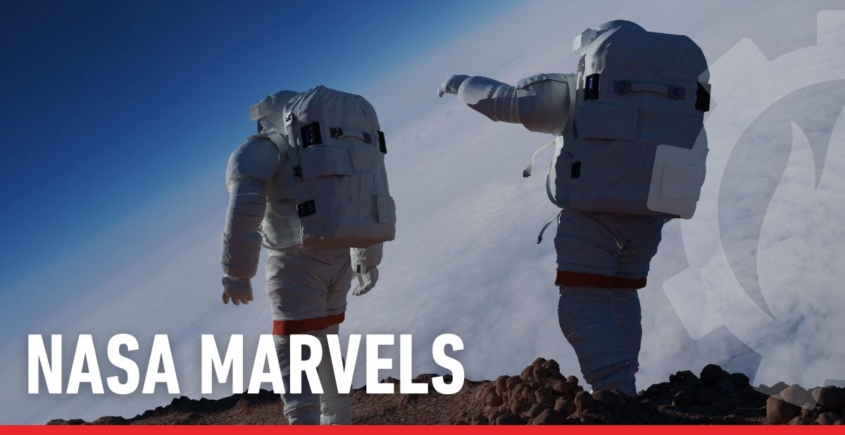NASA Marvels
I have to admit it – I’m a sucker for new inventions and amazing technology. While traveling out of town to attend a trade show in Vegas, I happened to drive past the large NASA technology center here in northeast Ohio, home to some of the world’s largest and most capable space simulation test facilities where ground tests are conducted for the U.S. and international space and aeronautics communities. A set of giant buildings, filled with engineers and scientists, developing breakthrough technologies that will someday be used in aeronautics … with some of them making their way into my home. (think TANG). Since we’re all about solving your PIA (pain in the @%$) Jobs, we kinda think of ourselves as pioneers in thermal processing technologies (I’d love to take credit for inventing ice cubes and blue tip matches, but someone beat me to it!!). Think about it – something as simple as Velcro (now part of my running jacket and sneakers) was first used for space exploration. I decided to do a search on products that were first made for space and air travel and then adopted for consumer use. Here’s a list of NASA-originated technologies that have transitioned into everyday consumer products, with a brief history and explanation of some hurdles each had to overcome. Thanks to Google for the insights. Enjoy!

By popular demand, we’re now sharing guides for the previous week’s logo contest!
Every Friday, scroll to the bottom of the post to review last week’s guide and see if we managed to stump you.
- Memory Foam – Developed in the 1960s for NASA’s airplane seats to improve crash protection and comfort by absorbing energy. Early versions degraded quickly and were too temperature-sensitive for consumer use. Improvements in durability and adaptability led to its widespread use in mattresses, pillows, and other comfort products.
- Cordless Tools – Black & Decker partnered with NASA to create battery-powered tools for space missions, such as drills for collecting moon rock samples. Miniaturizing reliable power sources and motors for cordless use was challenging. This paved the way for modern cordless drills, vacuums, and kitchen gadgets. (who didn’t have a ShopVac).
- Insulating Blankets – NASA developed lightweight, reflective Mylar thermal blankets to insulate spacecraft. Initial materials were not durable or flexible enough. Refinements allowed the use of Mylar in emergency blankets, building insulation, and food packaging.
- Scratch-Resistant Lenses – NASA developed scratch-resistant coatings for astronaut visors and spacecraft windows in the 1970s. Creating coatings thin enough for optics without compromising durability required breakthroughs in material chemistry. This technology is now used in eyeglasses and sunglasses.
- CAT Scanners – Originally, NASA developed digital signal processing for space imaging, which later contributed to medical imaging technologies. Adapting space data-processing techniques to medical imaging was complex due to the difference in data density and human health requirements.
- Water Purification Systems – NASA needed efficient ways to purify water on spacecraft. Miniaturization and energy efficiency were major challenges. Modern consumer systems use similar filtration technologies, including UV and charcoal filtration.
- Freeze-Dried Food – Developed to provide lightweight, shelf-stable nutrition for astronauts. Retaining nutritional content and flavor was difficult, but innovations led to commercial freeze-dried meals and snacks.
- Shock-Absorbing Athletic Shoes – Shoe companies like Nike used cushioning technology developed from space boot design to create more comfortable running shoes. Creating cost-effective yet high-performance materials was critical for mass-market success. Almost every shoe I own now has some foam cushion in it.
- Temper Foam (used in Prosthetics) – Adapted from memory foam technology for cushioning in prosthetic limbs. Durability and heat management for sensitive human use required optimization beyond original space applications.
- LED Lighting – NASA’s experiments with LEDs for growing plants in space helped improve energy-efficient lighting. Early LEDs were expensive and inefficient. Improved designs have made LEDs commonplace in homes, vehicles, and electronics.
- Infrared Ear Thermometers – NASA’s infrared technology for measuring star temperatures was adapted for non-contact temperature readings in humans. Miniaturizing the technology and ensuring safety and accuracy for medical use was essential.
- Anti-Icing Systems – Developed for spacecraft and planes to prevent ice buildup in extreme conditions. Implementing reliable, lightweight systems for consumer vehicles and wind turbines required additional engineering.
- Solar Energy Panels – Solar cells were refined by NASA to power spacecraft. Early solar panels were expensive and inefficient. Cost reductions and efficiency improvements have made them viable for homes and businesses.
- Portable Vacuum Sealers – Vacuum-sealing technology was used to package food for space missions. Commercializing compact, user-friendly versions required new designs and materials. We use these to seal up products for shipping.
- Fire-Resistant Fabrics – After the Apollo 1 fire, NASA worked on developing fireproof textiles. Combining comfort, flexibility, and fire resistance posed challenges, but the technology now protects firefighters and racing drivers.
I’m working on a golf ball that goes in the direction I tell it to – so far, even when yelling, it’s not working so well. But, I’m determined!
How did you do on last week’s logo contest?
Check out our logo guide for the “Pair Up for Valentine’s Day” post here!






Leave a Reply
Want to join the discussion?Feel free to contribute!